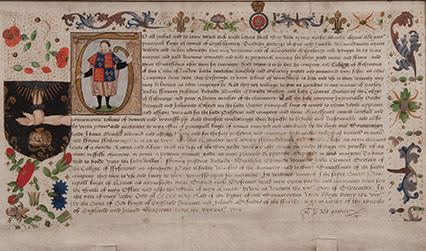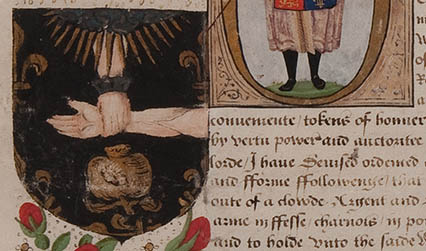The Grant of Arms – the 1546 manuscript giving the RCP permission to use a coat of arms –was the curator’s curiosity on display in July 2018.
Granted in 1546, the coat of arms of the Royal College of Physicians (RCP) has always been an important part of its identity. The style has been adapted over time, to match changing artistic preferences. But the basic details of the design have not changed.
What is a coat of arms?
The Collins English dictionary states that a ‘coat of arms of a family, town, or organisation is a special design in the form of a shield that they use as a symbol of their identity.’ This special design always uses colours and shapes which make up the system known as heraldry.
Heraldry began as a way to identify fully armoured knights on the battle and tournament field during the middle ages. Knights painted personal designs on their shields and clothing to help others recognize them. These were meant to be seen at a distance, so large shapes and bright contrasting colours were used.

By the middle of the 13th century a system of fixed rules for the design developed. This included how to describe heraldic designs in words, called "blazoning". Once it was no longer so important for battlefield identification, heraldry began to be used in its modern sense, by people, organisations, cities, towns etc. to symbolize their history, achievements, and hopes.
What symbols are used?
The blazon (formal description) in the 1546 grant of arms to the RCP states:
Sables A Border with Demy fflourdeluces golde in the Chefe an arm charnois oute of a cloude Argent and Azure with the Rase of the Son golde with a Cuffe ermin the hand ffelynge the powllse of an arme in ffesse charnois in point a powme granate golde
Translated into modern English, that is:
A black border with golden half fleur de lis, in the top a flesh coloured arm out of a silver and blue cloud, with the rays of the golden sun, with an ermine (fur) cuff, the hand feeling the pulse of a flesh coloured arm, on top of a golden pomegranate.

The specific elements which make up a coat of arms are carefully chosen to reflect the identity and interests of the recipient. Every formal coat of arms is unique to each recipient and is permanent. So, what impression did the RCP want to make with its coat of arms in 1546?
The heraldic symbols on the coat of arms have different symbolic meanings:
- The colour black symbolises constancy
- The fleurs-de-lis symbolise royalty
- The colour silver symbolises sincerity
- The colour blue symbolises truth
- The rays of the sun indicates divine authority
- The fur cuff symbolises dignity and status
- The hand feeling the pulse symbolises a doctor diagnosing disease
- The meaning of the pomegranate has been contested, but it may refer to regeneration in classical mythology, or to the medicinal plants used to treat disease.

We don’t know for sure what impression the RCP wanted to make, as there is no discussion about getting the coat of arms in the official records. But, looking at the heraldic design, we can make a guess:
Physicians are trustworthy, have royal and divine support for their authority, are of a good social status and are skilled in diagnosing and treating disease.
Although the 16th century society in which the original RCP fellows lived no longer exists, many of the goals of that small London society remain the same. Physicians today remain committed to being known for embodying professional values, improving their skills and knowledge, to deliver better health and healthcare.
Pamela Forde, archive manager
In celebration of the 500 year anniversary, the RCP Museum team developed a heritage trail called Curator’s Curiosities to share with the public some of the more curious stories behind our special collections. Alongside special purple signs around our Regent’s Park building, it featured monthly rotating displays of treasures from our stores which are rarely exhibited.
